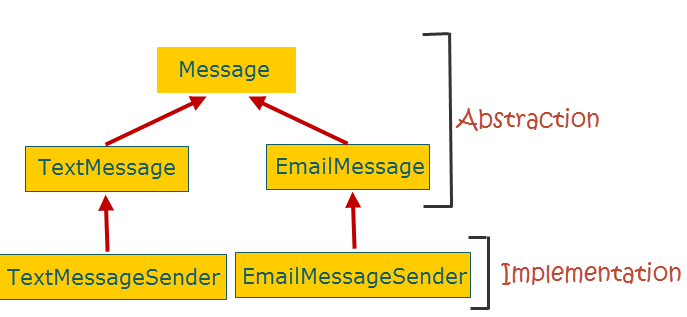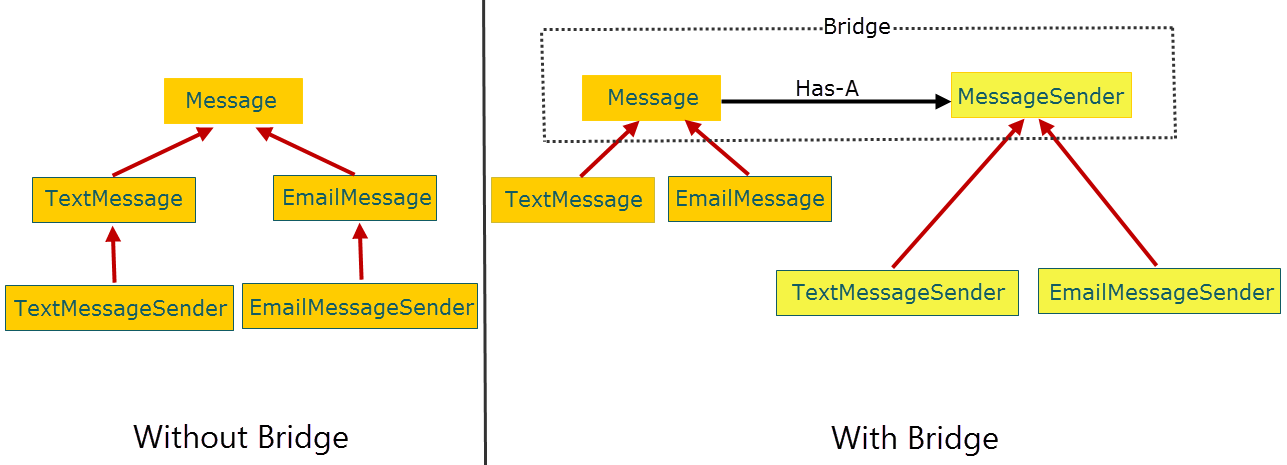Bridge pattern
Definition
“Decouple an abstraction from its implementation so that the two can vary independently.”
Introduction
We use abstraction to decouple client code from implementations, and the usual way is to use inheritance. We define an interface or an abstract class and create inheritance hierarchies from it, one for each of the several possible implementations. Although at first look this approach appears logical and nothing wrong in it, abstractions through inheritance isn’t always flexible. When we use inheritance, we are permanently binding the implementation to the abstraction. As a result, any change made to one affects the other. A more flexible way is to separate the abstraction and the implementation, and this is where the bridge pattern comes in.
Similar to the other patterns of the classic Gang of Four structural pattern family, the objective of the bridge pattern is to identify how to realize relationships between classes and objects in a simple way. The bridge pattern does it by separating the abstraction and the implementation in separate class hierarchies. The bridge between the class hierarchies is achieved through composition.
Participants
To understand how the bridge pattern works, consider a messaging application that clients can use to send different types of messages, such as a text or an email message. The most intuitive approach is to first create an interface or an abstract base class, Message. Next, we create the derived classes: TextMessage and EmailMessage. Finally, to send messages, we create two message sender classes: TextMessageSender that extends TextMessage and EmailMessageSender that extends EmailMessage. This is how our inheritance hierarchy looks like.

At first sight, there appears nothing wrong in the design above. But if you look deep you will notice that the abstraction part- the part that clients interact with, and the implementation part- the part that provides the core functionality of sending messages, are tightly integrated. Our design relies on inheritance and one inherent disadvantage is that it breaks encapsulation. As a developer of the EmailMessageSender subclass, you have to know about the internals of the EmailMessage superclass, which means the encapsulation in the superclass is broken.
Our design is also fragile. As an example, if we change the implementation to allow clients to optionally encrypt the message before sending, we will need to update the abstraction part to make the encryption functionality available to clients.
Another issue is reusability. If we want to reuse only the implementation (message sending) part in some other application, we will have to take along the abstraction part as extra baggage.
The bridge pattern addresses all such issues by separating the abstraction and implementation into two class hierarchies. This figure shows the design without and with the bridge pattern.

With the bridge pattern, the abstraction maintains a Has-A relationship with the implementation instead of a IS-A relationship. The Has-A relationship is achieved through composition where the abstraction maintains a reference of the implementation and forwards client requests to it.
Let’s summarize the participants of the bridge pattern in the context of the messaging example:
- Abstraction (Message): Is the interface implemented as an abstract class that clients communicate with.
- RefinedAbstraction (TextMessage and EmailMessage): Are classes that implement or extend Abstraction.
- Implementor (MessageSender): Is the interface of the implementation class hierarchy.
- ConcreteImplementor(TextMessageSender and EmailMessageSender): Are concrete subclasses that implements Implementor.
Conclusion
The bridge pattern looks a lot like the adapter pattern and is a common cause of confusion. However, while the adapter pattern helps two incompatible interfaces work together, the bridge pattern helps decouple the abstraction and implementation by creating two separate class hierarchies. Also, as stated by GOF “Adapter makes things work after they’re designed; Bridge makes them work before they are.“.
So, when doing Enterprise Application Development with the Spring Framework, if you think about creating deep class hierarchies for different implementations, consider separating the low-level implementations into a separate class hierarchy connected with a bridge. Doing so will make your code more flexible and less fragile to changes. Also, with the bridge pattern in place, it will be much easier to unit test your code. Without the bridge pattern, in order to test implementation classes, you need their super classes. With the bridge pattern, you can test them independently, and then create mock objects of the implementation classes to test the refined abstraction classes.